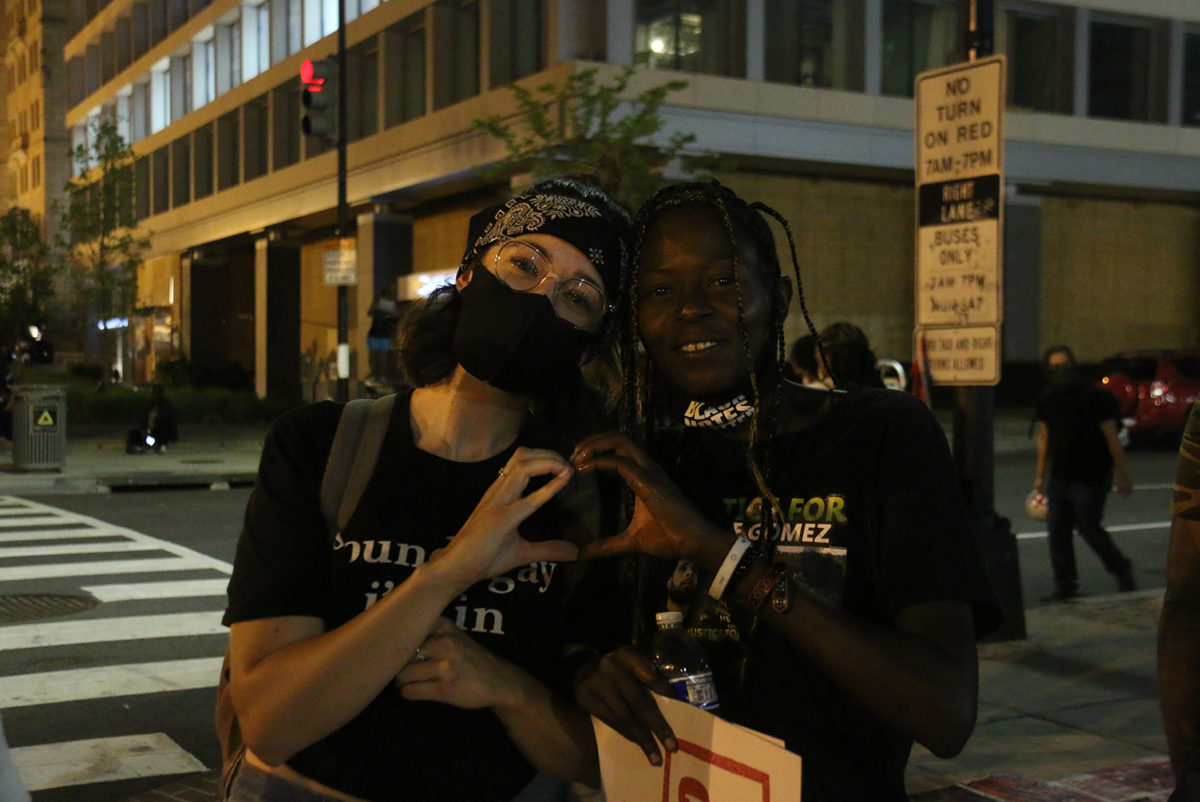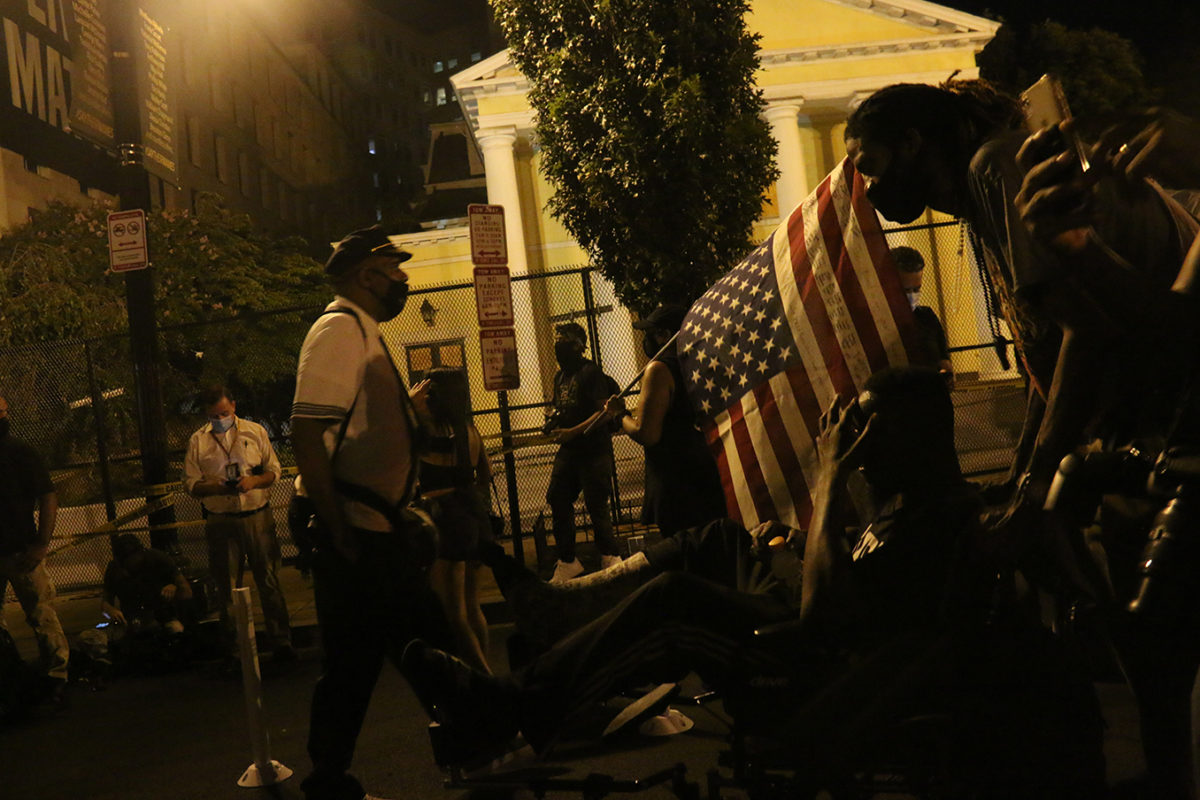
I. Tuesday, August 25, 2020—10:00 a.m.
It’s 10 a.m. at McCarran Airport and I’m waiting to board a plane to Baltimore for the 2020 March on Washington. In short order, ten members of the activist organization Las Vegas Liberation join me as the plane is packed like a tin can full of COVID risks. We are going to the 57th anniversary of the historic March on Washington. A vibration of excitement runs through my traveling companions, invisible to the docile, hungover tourists returning from their Las Vegas vacations.
We land in the evening, navigating from the plane to a trolly, to a train station where we wait in the humid night air. Our travel conversations range from our favorite vegan snacks to the recent murders of two protesters by Blue Lives Matter supporter Kyle Rittenhouse in Wisconsin the previous evening. Police brutality, institutionalized violence, and the increasing racial and political tensions that surround four solid months of national protests are almost casual topics of conversation within this group. They speak about these subjects as one might discuss a favorite show on Netflix, but with an edge of frustrated sobriety you would expect from people in the thick of making social change. I’m at least a decade older than everyone involved in the trip. The normalization of tragedy for people so young wears on me, especially as I navigate the difficult status of journalistic observer. I’m sympathetic to their cause, and have even participated in protests myself, but this time I have a journalist’s distance to maintain. I’m here, reporting on spec for a local publication. I remind myself that I am here to observe, not to get involved.
The train takes us to a bus station. While waiting for the bus, I overhear Teresa and Zyera, two of the activists I traveled with from Las Vegas, discussing the generational differences in activism. They agree that social media and the easy accessibility of information on the web have led to a more realistic perception of our collective history, and greater connectivity between like-minded people. These sentiments, though not unusual, now strike me with new resonance. Over the last few years, I’ve come to perceive the internet as humanity’s great epistemological nightmare, a device for sowing division and confusion. Still, I cannot argue against the positive aspects of the internet, such as engagement and activism. The new accessibility of historical information gives many in the group a firm belief that they can advance the agendas of past movements while learning from their mistakes.
It’s late when we arrive at our D.C. Airbnb. As residents of Las Vegas, a 24-hour city, we easily forget that most grocery stores and restaurants in other places have 10 p.m. closing times. We also forget that mosquitos exist. We split up. Kenny and I walk to get falafel and pizza and another group goes to the liquor store. It takes a few hours but everyone gets fed, especially the mosquitos.
The house lights up with energy. We pour libations and play cards; it feels warm, welcoming, even homey. Most of us adjust to one another’s cohabitation styles and are rarely grating and always accommodating.
I take a break from the rabble in the house. A wooden swinging bench hung on the front porch with the quaintest kind of East Coast domesticity finds me. I’m stoic, maybe even depressed, laid low by the weight of ongoing and impending historical events. I search myself and find myriad reasons for such internal melancholy but no solutions for shaking it. The last time I felt enthusiastic about this world, nation, moment in time, I was photographing protesters streaming across Las Vegas Boulevard some time in mid-May. Blisters covered my feet from days and nights of walking and documenting the protests. I believed that chronicling these events was the most effective form of support I could show for the latest in a long history of American movements.
Back inside, Zyera is testing her megaphone. The words of protest explode through the house with defining electricity:
“POWER TO THE PEOPLE!”
“BLACK LIVES MATTER!”
“FUCK TWELVE!”
Everyone in the house fully participates in the call-and-response chanting method that I’ve become accustomed to while documenting local protests. I’ve seen this pink-frohawked mother of five command hundreds to block off Las Vegas Boulevard. (As I write this, in mid-September, Zyera is serving a week-long sentence at the Clark County Detention Center for her protesting activities.)
II. Wednesday, August 26, 2020—12:18 a.m.
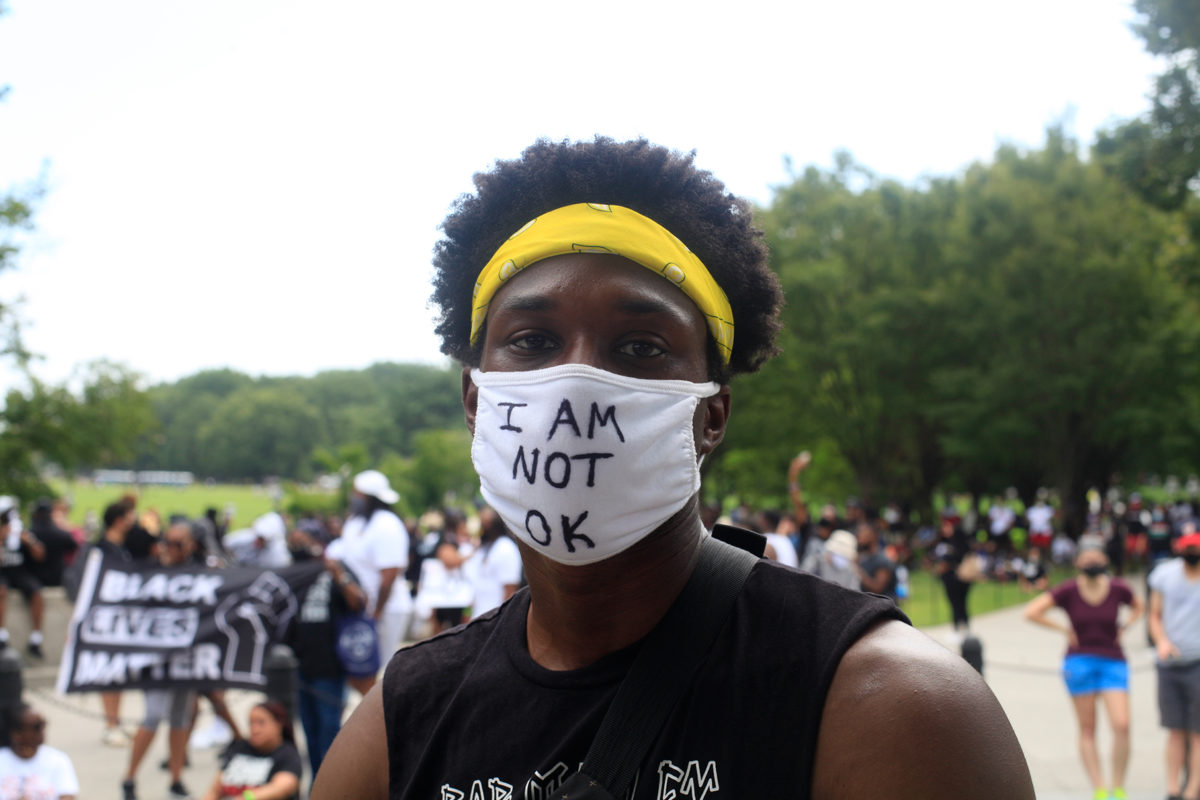
In two days, the March on Washington will begin. I lie awake in bed, and echoes of laughter and the sound of card games emanate from the living room below. Comfortable but restless I interrogate myself, questioning my own motivations for coming. Am I an activist? No, certainly not by Zyera’s high standard. A concerned citizen? Yes, of course. But how does my Blackness play into this? It’s been nearly 100 days since the death of George Floyd. I’ve attended dozens of rallies and protests, chasing something I cannot completely describe, a catharsis that remains unrealized.
I’m a Black man, forty years old. I was raised primarily in upper-class suburbs surrounded by whiteness and privilege, and certainly buffered from many of the harsh realities of living while Black. My parents moved our family from Los Angeles to New Jersey a few months before the Rodney King riots. In my youth, most of my friends were either white or Jewish. At its most impoverished, my family still lived cozily in a two-story house larger than the one we eleven are collectively occupying tonight. I spent my debauched twenties in the dive bars and house parties of the Las Vegas arts scene, not organizing for causes, not fighting for my rights. I’ve had my fair share of negative police interactions—some deserved, an equal number undeserved. I wonder if my lifetime of messy complacency has in some small part led to the current state of the nation. My guilt tells me the activists I’ve journeyed with might not be called to action had I taken some kind of stand at their age.
I think of my mother: a brilliant, educated woman. I think of her parents: my grandmother was a school teacher. My grandfather was a man with a third-grade education who managed to co-found the first Black-owned credit union in the United States. He was still called “boy” when pulled over at traffic stops in rural Texas.
My mother made sure my siblings and I were fully informed of our nation’s history. Before adolescence, we knew about Tulsa Oklahoma, the Gullah-Geechee people, the Black Seminole Wars, the Harlem Renaissance in all of its glory, the sundown towns, the Chitlin Circuit, and the history of Black cowboys, who are a part of my family’s legacy. When I was twelve, my mother instructed me to read Lewis Nordan’s Wolf Whistle, a novel based on the murder of Emmitt Till, as a precursor to “the Talk” most young Black people receive as they approach puberty. Still awake, I think of a moment a few weeks earlier, when my mother admitted that she knew even when I was a young man that she had not done enough to fix the problem of race in relation to my family and the nation at large. She told me that at night she would sit in our kitchen and weep for the future.
Still ruminating, I recall walking to the falafel joint earlier this evening with Kenny, a tall white man who spends his weekend mornings outside the house of Las Vegas mayor Carolyn Goodman, chanting and protesting loudly in an effort to disrupt her sleep. This evening, as we walked, he constantly greeted everyone we passed, and was pleasant and self-assured. His demeanor made me pointedly aware of the difference between his and my behavior. Because he’s white, he has likely never been told to keep to himself on public streets after dark for fear of accusation or interrogation by the police. To White America, his body is not considered a weapon, and his presence is not a preconceived threat. As we made our way to the falafel place, I thought about the fear I carry daily that Kenny may never have to live with, knowing there is no more sacred pastime in America than the destruction of Black bodies. From our nation’s beginning, with the death of Crispus Attucks; to white Americans’ late nineteenth and early twentieth-century tradition of collecting and exchanging lynching postcards; to the media saturation of this current moment, where fresh new videos of Blacks brutalized, paralyzed, or killed by the very people sworn to “protect and serve” are pervasive, the image of Black death is America’s Pietà. I picture each new video like a coin dropped into a cup of water, rippling my psyche until all of my peace is displaced like so much tepid water. I think of my daughter and sons miles across the country and the futures they must live, and pray they look less and less like our past and present.
III. Thursday, August 27, 2020—9:37 a.m.
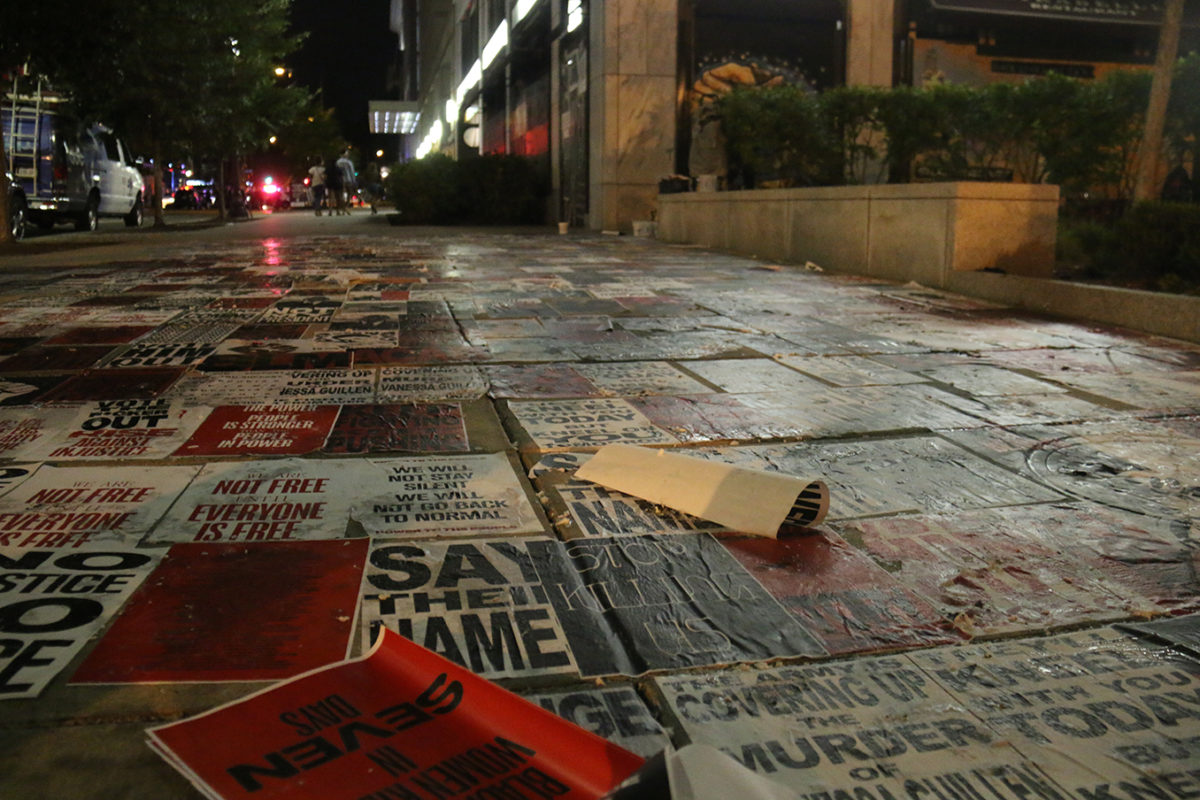
With a day until the march, I spend the morning with a brilliant, beloved artist friend who visits me from Baltimore. Braving highways and a chance of contracting COVID, she’s decided that I am worth the risk. She brings water and materials for protest sign-making and we drop them off with the rest of the group, who assure me that they will catch up with me later in the afternoon. We drive into central D.C. on a sunny Thursday and converse about the state of the world, the current administration, our economy, the pandemic, what we did with our quarantine summer vacation. We split uninspired chicken tenders in the sculpture garden at the National Mall and note that Washington D.C., like most cities in the U.S., is in some kind of awkward COVID limbo, a fact compounded by its status as a majority Black city, especially given the higher rates of death and hospitalization in Black communities. The usual street vendors that would sell you an incredible Jamaican patty for five bucks are nowhere to be seen across the verdant stretch of well-manicured grass that rolls downhill to the Lincoln Memorial, which is where we decide to end our visit.
At the memorial, the preparation for the March is already done. Scaffolds and a small army of folding chairs pepper the marble platform. Video equipment and giant LED screens stand like monoliths to our media age. The Lincoln Memorial is our nation’s most secular temple and it maintains the air of one despite the addition of event equipment. It is awe-inspiring just as it was when I was ten and found myself guided upwards by my mother’s gentle hand. Her proto-woke explanation of old Abraham’s motivations for engaging in the Civil War was that he was less interested in freeing our people than in preserving the Union. Her refusal to deify this massive stone man must have contributed in some way to my unshakeable rebellious streak.
As I ascend, the marble reflects warm sunlight. Each stair step and the combined weight and airiness that only the imitation of Greco-Roman architectural sensibilities could lend to a structure manage to strike my heart as sacred in some way. Nearing the top of the monument with its iconic view of the National Mall, I overhear three young men who stand at the top step remarking to the rest, “We made it.”
I came to find out that making it was a long journey. Two of the men who stand before me have been walking for months all the way from Minnesota. Cortez Rice and Tim Williams are nephews of George Floyd. Cortez is lying down on a park bench a stone’s throw from the Memorial, being attended by protest medics for the aches and exhaustion that come with taking such an innumerable series of footsteps.
In his exhaustion, he relays the lighter details of his journey: they moved on foot from north to south, and encountered support and assistance as well as hostility and violence. His traveling partner Tim, sitting nearby, relays the feeling of brotherhood and the growth he’s experienced on their long journey together. They tell me their story can be viewed bit by bit, day by day on their Facebook live feeds. It is not the most intriguing narrative you’ve ever seen, but it’s quite inspirational for a platform typically used for memes and arguments.
My conversation with them points to what I’ve been growing aware of all day long. These men expect something from tomorrow’s march. This event has become a mecca, not just for myself but for so many activists and concerned citizens all over the nation. It weds the Black Lives Matter movement and MLK’s Civil Rights movement in historical continuity. It is a thread sewn from present to past, an act attempting to simultaneously vindicate and eulogize the efforts of so many in the struggle for justice. I’m here, I think, to bear witness, as I have throughout so much of this difficult and burning age. Or, like my fellow pilgrims, am I searching for something more, some kind of anthropological alchemy?
IV. Thursday, August 27, 2020—3:53 p.m.
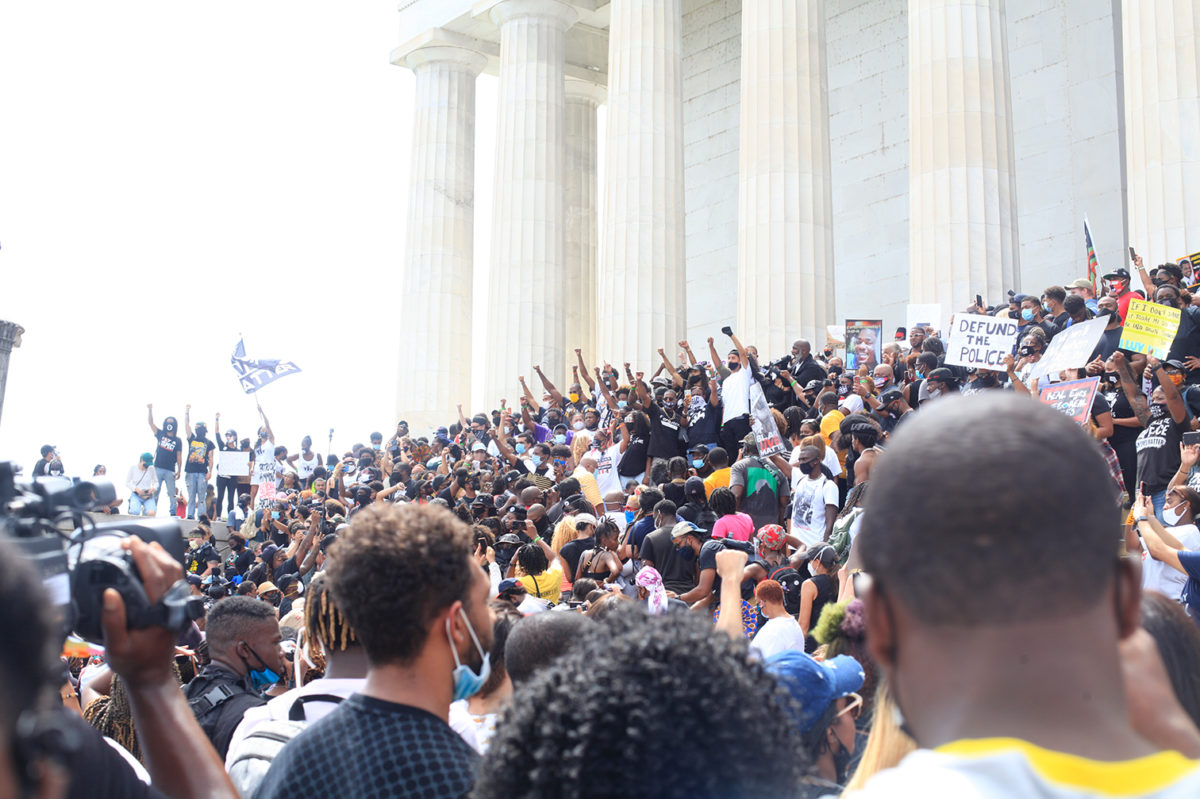
By late afternoon the LVL crew arrives at the National Mall. They have taken a long bike ride across Washington, a mode of transportation they collectively regret having engaged. There are conversations about the heat and the day and the hidden expenses of using the D.C. bikeshare program, but the most interesting thing discussed is the protest brewing in front of the White House a few miles away. Today is the day that President Trump will accept his party’s nomination for president in a speech broadcast for the Republican National Convention. Protesters have assembled to make as much noise as possible in order to interrupt his acceptance speech, which is unusually delivered from the office he currently holds and is running for again.
The street along the southern end of the White House is packed with vendors, no protests in sight. I’m taken aback a bit by the retail aspect, something that Natana, a mother of three, social worker, and fledgling activist brings up as well. Black Lives Matter T-shirts, hoodies, masks, bags, are everywhere, completely lining the street. I’m not unsupportive, but an inherent repulsion around the financial exploitation of such an emotional ideology polarizes my moral compass. Then I buy a bright yellow tank top because This Is America and muse: I went to the March on Washington and all I got was this shirt that says “Black Lives Matter.” (And a lingering sense of solidarity!!!)
We leave the BLM market, each of us having indulged our capitalist appetites. As we walk towards Pennsylvania Avenue, the black fence that first appeared to be a nondescript feature of the landscape suddenly becomes striking to me. I’ve heard of this installation in the media. I knew that the president added a reinforced military-grade fence around the executive branch, but in person it’s another thing. In the setting sun, it’s a wall of shining onyx with the smallest perforations imaginable allowing you to glimpse what lies on the other side. I take into consideration that I have no historical frame of reference for this object. I’m not aware of a time that the commander-in-chief required so much insulation from the American public, but these are ahistorical times, with an ahistorical leader, at least for our nation.
Slowly, the sound of a crowd begins to echo off the concrete walls of the surrounding businesses, a mass of voices growing ever louder until there it is. At this moment I feel like a tourist engaging in the oddest sightseeing I’ve ever known; this won’t be the last time I encounter those feelings. The crowd is at least five hundred people deep, and folks hold banners and posters with numbers drawn on them. Moving at a steady pace, they walk back around the corner to the South Lawn of the White House chanting and drumming.
“I’ve got your back if you’ve got my back” is my favorite chant uttered by the imperially beautiful Black woman that is leading the line. Another resonance hits me as I stand filming and photographing this raucous parade. From a distance, I hear music that’s both vibrant and sweet. I feel compelled and break from the protesters to chase a beautiful float.
(Here I indulge a brief aside about music and its importance: Dancing in the street to the sweet melodies of Sister Ivy filled me with more elation and catharsis than my arrival in D.C. or work at home organizing art around protests. I wonder: if we had better access to live music, would the pandemic have taken such a dreadful toll on our collective psyches?)
I rejoin my friends in front of the White House. It’s an incredible sight. Along the buildings facing the executive branch, there are hundreds of murals, posters, and flyers posted on boarded-up windows, naming the dead, calling for justice, decrying authority. I’ve loved art all my life and this art, it means something. Not in the post-grad MFA sense of deciphering and picking apart layered subtexts. Here, the artwork actually means something direct, real, and if we were for a moment to indulge in light analysis, it’s collaborative and free, elements that underlie the spirit of activism. There are no central pieces or featured work but hundreds of hands engaging in expression. This artwork is defiantly juxtaposed across from the very seat of power it wishes to dismantle. The proximity itself makes me wonder how close we may be to outright revolution.
The revolution itself is pregaming down the street on Black Lives Matter Plaza. Turntables set up in front of the big black fence revolve records, creating a carnival cum-protest atmosphere. It’s a party!!! It stretches three blocks in any direction you head. Not densely packed but still filled, the spaces between people electric with a mixture of celebratory cheer and righteous indignation. They are painting the street, making speeches, postering the fence to the White House, and dancing. So much beautiful dancing. It’s an incredible time. Eventually, we catch Ubers back to the Airbnb and everyone begins prepping for the March in the morning; many plan to leave early to be at the front of the line. In the distance, we hear a blitzkrieg of fireworks coming from the White House and we collectively acknowledge that the president must be done with his speech. Energized from the evening, it’s hard for everyone to sleep, and it’s not until 2 a.m. that the house quiets.
V. Friday, August 28, 2020—5:00 a.m.
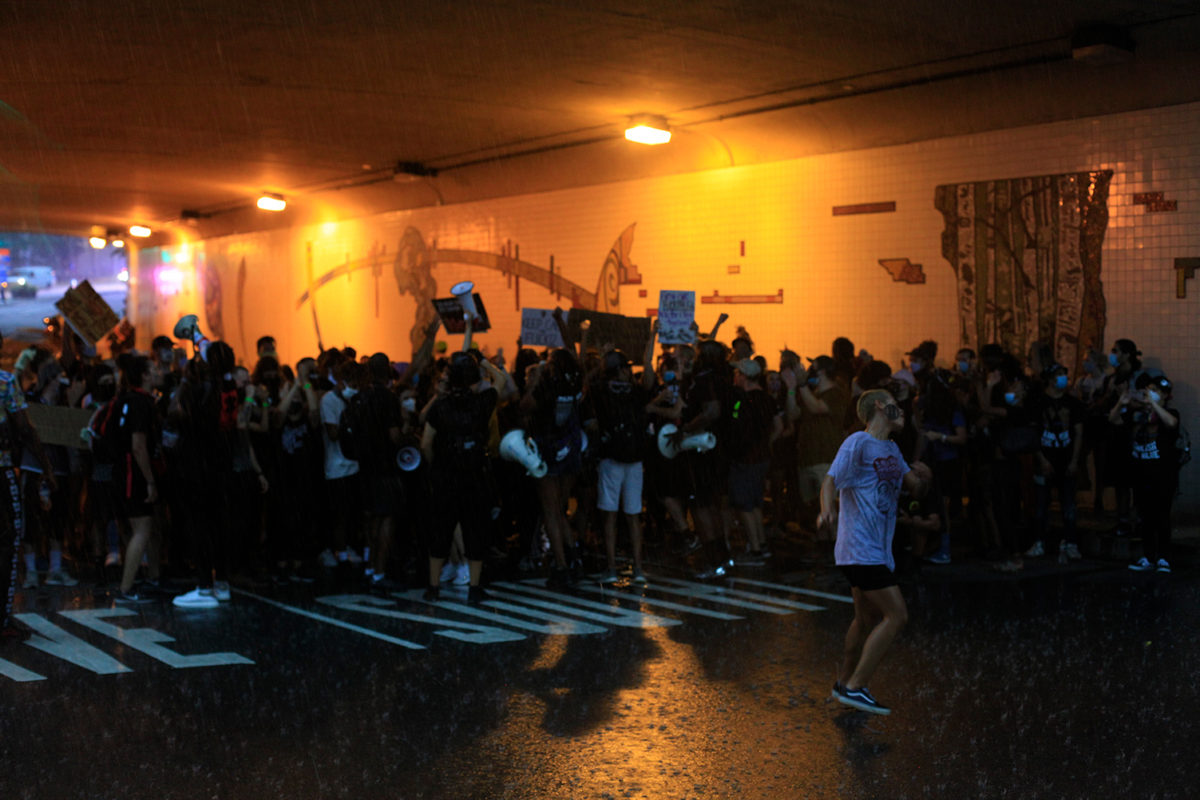
Today’s the day! My comrades are exhilarated. At 5 a.m., the first group sets out to the Memorial as thunder claps and the front door slams closed, awakening the late sleepers. It’s hard to get an Uber. The service seems reluctant to head to the National Mall, but I finally get one around 7 a.m.
Admission to the March is a simple process: wait in a very long line until you get your temperature taken and are issued a wrist band. The woman who takes my temperature is a glowing Black woman who radiates the same vibe as one of my Southern aunties. She gives the all-clear and says, with a smile, “Bless your life.” I suggest to her that we all choose this as a common cultural greeting from now on. The Memorial itself is sparsely populated so early in the morning. Despite the long lines, a small quiver of fear runs through me; I worry that this will be a low-attendance event.
It’s now 8 a.m., and I climb up the steps from the Lincoln Memorial Reflecting Pool, the marble structure riddled with moveable guardrails. This event organized by the Reverend Al Sharpton is like most outdoor events: a hodgepodge of blockades with volunteers perched around guard rails, directing the flow of human traffic to approved gathering zones. Using my press badge, I talk my way through some security checkpoints and find that Zyera is already at the top of the stairs interviewing a pair of mothers whose sons were victims of police brutality. Over the dissonant soundcheck they relay their stories. The injustices these women have suffered are sickening to hear. They hold images of their children’s battered bodies on large cardboard signs. In these tableaus their sons are once boys, and then, juxtaposed next to their childhood selves, they are corpses lying prone on autopsy tables, their flesh riddled with bullets, bone and muscle exposed to a coroner’s investigation. The moment of bloodletting is invisible like the hands and chisel of a sculptor.
Z’s warmth and attentiveness strike me as I watch her lovingly interview these women. Their persistent heartbreak at the loss of their sons is shot through a filter of rage at a system that defamed their loved ones after their deaths in order to justify the actions of police. There is so much recompense past due from the incredibly broken machine we call the American justice system that I will never mourn the destruction of a courthouse or police precinct as much as I will mourn the hundreds of lives lost to poor police protocol or malicious officer intent.
The event commences, and six hours of speeches are underway. At the end of them we will march over 3,000 steps to a memorial made for the man this event celebrates. Some speeches are striking in their progressive rhetoric, many are nothing more but a call to vote. It’s a long day, and I roam around photographing the ever-swelling crowd.
It is hot and humid and I find a few of the LVL crew are dozing in a shady area near the edge of the Memorial. I join them. We sip warm water and reflect. I wrestle with my dissatisfaction. This is an incredible event. The words of leaders from around the nation echo off the marble structures of the Lincoln Memorial, into abstraction, while I rest my mind and eyes. But I cannot shake the feeling of something absent. The Movement seems to lack a destination. The messages abound: yes get out and vote, yes Black Lives Matter, yes power to the people. But where are we heading? How can we reach these lofty and necessary goals in a culture overrun with dissenting opinions and didactic political talking heads that are losing more and more common ground on things that used to seem like common sense?
Is this a mecca or just a tourist destination? And are the voices I am hearing those of true allies or just opportunists? I’m startled awake by a younger female voice that is higher and louder than any I’ve heard that day. It is the voice of Yolanda Renee King, Dr. King’s granddaughter. She is energetic and performative, but more importantly observant and forthright. She is also twelve, and she delivers a speech that someone her age should never have to make. King is a young Black girl who speaks about civic duty, the path for true racial equality, and self-mastery. “We have mastered the selfie and TikTok, she says, “now we must master ourselves.” I ponder her ancestral burden. Her words are so powerful that I am glad the sweat on my face is so heavy it disguises my tears. She gives me the gift her grandfather gave so many: hope.
A bit refreshed, I get up and move through the crowd, stopping to linger in places. I am smitten. I’m surrounded by representations of Blackness that exemplify our diversity and individuality: the militants, the hipsters, the fashionable, and the grimy. I see representations of my race in all of its splendor, a panoply of melanin. Simultaneous feelings of elation, alienation, wonder, and sorrow travel through me. I know I will most likely never again see this many members of the African diaspora at the same time with such intense variation. That in and of itself has made this journey gratifying. The speeches continue and the voices of those who have lost loved ones to police brutality give a collective cause for weeping. It’s an onslaught of grief, a succession of group mournings. Al Sharpton speaks and the rally begins to trend towards the march.
The barricades and checkpoints have given way, and masses of people are now crowding onto the steps of the Lincoln Memorial all the way up to Honest Abe’s den. For the second time on this trip, I climb to the top of the monument to view the ocean of humans below, to see history being made anew at this latest March on Washington. It is so similar to the image we all have in our history books and so very different. Sixties photography could never provide this color. Also, in the images that will be taken of this event, there is a greater sense of anarchy than in those that came before; now, one sees bodies standing in the Reflecting Pool, climbing the sides of sculptures, not stuck in the uniform throng of organized people that you can find in pictures from the most famous march.
Las Vegas Liberation members Aries, Nick, and Rick have followed me through the crowd. We embrace, laugh, dance, take pictures of each other, the vista, and Lincoln with his massive stone face calmly gazing down upon us all. Again, I feel a nagging suspicion about the ostentatiousness of the activism I’m witnessing, but I perceive that this destination, at this moment, will not be something repeated. Rick remarks that in most of his moments at protests, the people he travels with veer away from the difficult and risky activities, like climbing walls, jumping barricades, dodging tear gas, or standing in the no man’s land between protesters and police officers. I retort that the thing we have immersed ourselves in is the business of risk. Giddy in the moment, we reach an apex, and we all swear to one another that within our lifetimes this moment will be remembered by each of us.
I do not know what the air was like when MLK began his march, but after a soft pause for a BeBe Winans performance, there is a bubbling in the crowd more intense than any hardcore show I threw fists in during adolescence. The March begins and a trickle of bodies becomes a flash flood.
Marchers stream in all directions, chanting the familiar and unfamiliar slogans, laughing and dancing seriously but not sternly. We march a long way until we reach the MLK memorial, the energy of the collective driving my body forward. I’m aware of the performativity at this point, the ways in which large groups of people create a theater of expression, the sounds and movements in collective unity, a parade yes, but a parade of conviction. How bodies are used to build walls and form chains, the inelegant dance of it all. A show, not meant to entertain but educate, express, and convince. Protest, I realize, is an incredible art forum.
Once arriving at the MLK memorial, the mass of people split. I am struck by the idea that we have marched to the monument of a man who left us with so much work unfinished. I am dehydrated and famished; the main event is over and I take care of my hunger and thirst. Teresa and I meet up. We run through the rain. She is fleet and hale, and unlike myself, she was a runner in school. (“Eleventh-fastest in the country,” she brags.) Our difference in exhaustion is notable. We move towards the National Mall to catch a ride back to the Airbnb with Kenny.
The Presidential motorcade passes us. It is a gleaming black affair with red and blue lights flashing and hurtling through the daylight. The surrounding citizens make rude gestures and yell expletives but that doesn’t affect the sprinting black cars. I do wonder where ol’ Donnie is going. I wonder if it concerns him at all that the streets of this city are lined with those that would rather jeer him than cheer. I doubt that it does. I am tempted to but will not linger on this man’s intrusion. I think we’ve all done enough of that.
Drained by the day, we prepare to head home until we spot a different protest: anarchists with black and red flags, and banners chanting about dismantling our nation’s law enforcement. Their mood is much darker than the crowds we just left, the warmth and resonant cheer is gone. The sky supports this mood as dark grey clouds roll in behind the protesters. Teresa, Kenny, and I reconsider going home. We follow for a while but through a strange coincidence, or perhaps an elegant plan, another protest is traveling down an intersecting street. This protest’s movement is a bit less menacing but still powerful. I see several familiar faces from Las Vegas protests have flocked to this place at this time, following the flames of revolution.
We switch and join the second group heading back towards the National Mall.
The sky grows darker, and thunder crackles overhead. The protest is trailed by a fleet of police officers on bicycles. Squad cars and a paddy wagon can be seen in the distance. I do feel a twinge of fear at the prospect of being arrested miles from home, most of my bail money spent on a BLM t-shirt, Uber, and snacks. Thankfully, the police seem to be observing, not interacting.
It begins to drizzle. As the rain starts to come down hard, we march over a bridge two blocks from the mall itself into a pair of tunnels, leaving a cloud-draped Washington Monument far in the distance. This moment is beautiful. The tunnel is illuminated by tungsten, and the lights glow warm. The chants echo, and the entire space vibrates like a cathedral of civil unrest. Teresa, Kenny, and I smile at one another, having briefly found what we have been looking for all day.
A chant I’ve never heard before reverberates from the second tunnel out into the dark gray deluge.
“I BELIEVE THAT WE WILL WIN.”
It becomes musical, rhythmic, even sing-songy. This statement resonates with me, despite the hardened cynicism that comes with decades of observing the erosion of our civil liberties, a ruthlessly divided sociopolitical landscape, a nation in which it is controversial to say that my life matters, the murder and disregard of countless Black and brown lives, and the creeping threat of global fascism. I watch a tinder stick of a woman dance soaking in the rain, a black-clad anarchist spray-painting the walls of the underpass with the ferocity that can only be achieved in a fugue state, and I think, We will win, we haven’t any other option. The other end of this dispute is greater folly than our ancestors will be capable of permitting.
Towards sunset, the rabble begins to fade with the downpour. Kenny compels me to get some falafel at a shop a stone’s throw away. I am hungry and falafel is my bedrock dining choice. It’s the best meal I’ve had all week. When we step back into what remains of the protest, the tunnel has dissipated into a nearby overhang. We huddle with a spotty crew of leftovers from the larger group. The spray-painting anarchist is still at it. Now she’s painting on the wall of the falafel place itself, and security is there but inactive. Several people in the group point out that they’re watching her, and once she notices, she quickly hides her rattle cans and darts off into the overcast sunset. Moments later, I am confronted by a maintenance worker who observes my unblemished hands, my wet but fresh T-shirt and clean blue jeans and says, “You know I’m gonna have to clean that mess up.” That is correct dear reader: on this day, the anniversary of the “I Have a Dream” speech, I am being profiled by what I’m sure is a generally very kind man within the realm of his duties and regular life, but somehow he pegs me for the graffiti culprit in this crowd where I am only one of two Black people. The security guard steps in to explain that he saw the whole thing and that I had no involvement. The maintenance worker apologizes swiftly, but I’m no longer listening. Instead, I’m locked into multiple memories of adolescence where despite my privilege and insulation, I was frequently considered problematic, even though I ran in circles with more actively devious young white men and women.
Standing in the incandescent light, I remember a school field trip where a group of boys in my class broke a glass-encased lamp post. I was uninvolved but blamed for the vandalism, and lambasted both by my educators and my parents. The trouble was a consequence of my ethnicity and proximity.
I snap out of my reverie. Kenny and Teresa have summoned an Uber and we hop in. We arrive back at Airbnb to be received by the rest of our cohort. Everyone recounts their day, the heat, the speeches, getting lost, and getting found again. Z, in her typical fashion, led a group in chanting and marching from the Lincoln Memorial to the MLK one; reliving her busy day, she practically glowed with ecstatic surprise at all that happened to us. All of us are exhausted. The conversation becomes casual and we begin to pack our bags for a red-eye flight back home.
VI. Saturday, August 29, 2020—12:24 a.m.
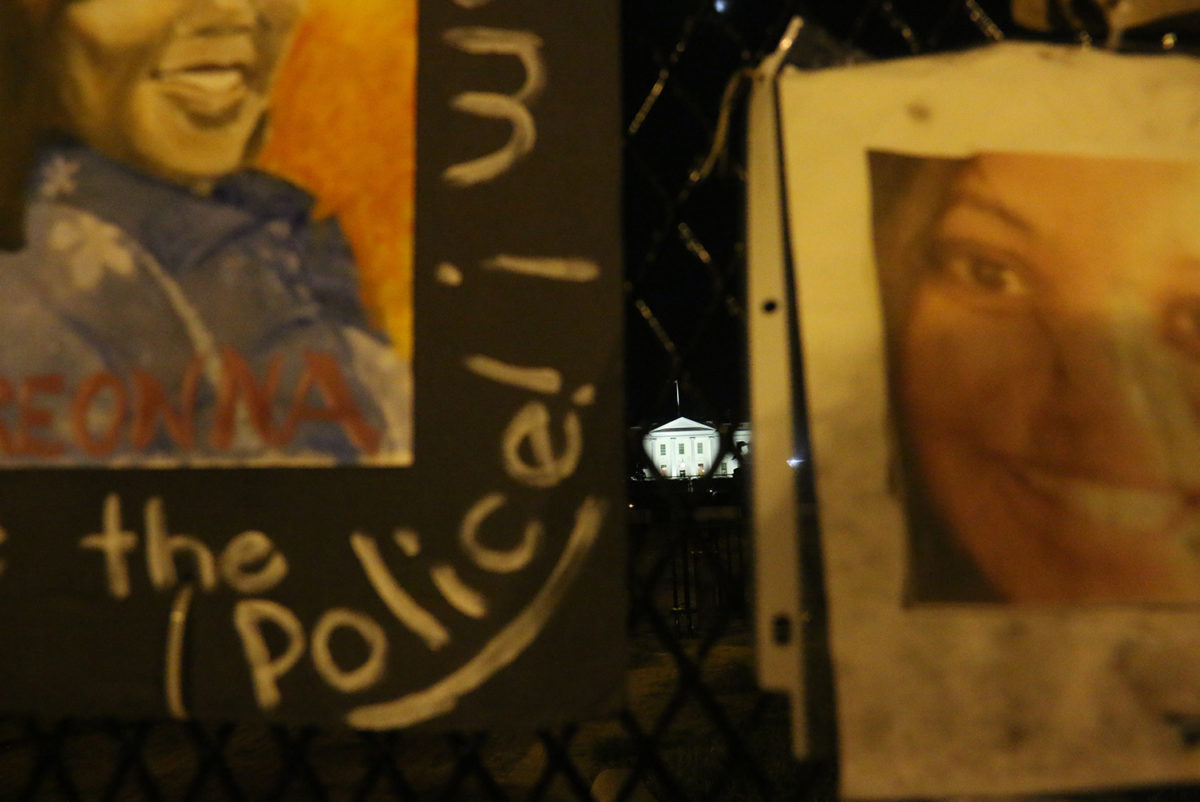
This flight is sparse, less nerve-racking than the first and we arrive back home in due time. The entire group is appreciative of one other as we say our goodbyes. My compatriots are so admirable. These young people have found passion and drive for something beyond easy celebrity and social acclaim. I find them all so beautiful and moving. Days later, I reach out to some by message and phone. They tell me that their experiences at the march reaffirmed their convictions, galvanized them to work better and longer, and gave them hope for real change.
For my part, I’m unsure what I brought home with me (a rapid test the next week confirmed it was not COVID-19). The shoestring around my heart is weighed with many burdens, some personal, but most increasingly humanistic. When I get home, my four children are sleeping. The sight of them resting while the world is aflame obligates me to engage whatever threat this world may render.
As far as my relationship with activism goes, I have more questions than answers. I know I’m not a tourist. Not any more. Tourists visit a place. They can love it and care about it but it is not their home. I know that I’ll spend whatever days this world will hand me working towards effective change. I know that observing, telling stories, and presenting the course of events matters. I am also certain it is not enough. Not enough to abate the existential threat of white supremacy, and police brutality, its offspring. I’m not sure what course of action would be enough. Months later, I don’t know if the March on D.C. was cathartic. It certainly was not a great media frenzy, but within an ever-shifting landscape of catastrophe, and a chaotic media cycle, it’s difficult to make even the most monumental events last long in the public imagination. There is no great moment in all of this, no climax and aftermath. The history of now will be told in ways I cannot possibly imagine. The stories we tell future generations about this time will make them shake. I pray the shaking gives way to dancing when the burdens of this era have been lifted. I can say with clarity that in our current tumult and division as a nation, something’s got to give. I pray it is not our humanity. I believe that we will win.
